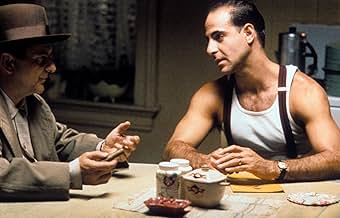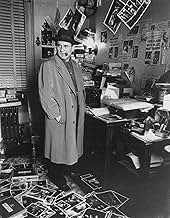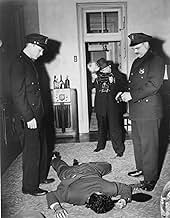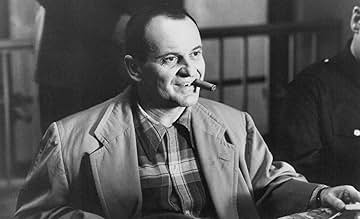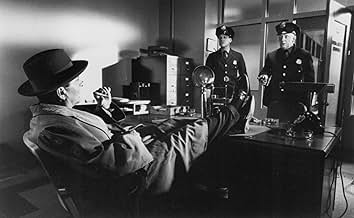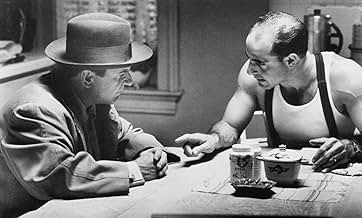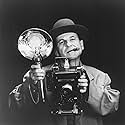NOTE IMDb
6,5/10
4,7 k
MA NOTE
Année 1942. Leon Berstein, le photographe le plus roublard de New York, est contacté par la belle Kay Levitz qui lui demande de réunir un dossier compromettant sur le gangster Spoleto.Année 1942. Leon Berstein, le photographe le plus roublard de New York, est contacté par la belle Kay Levitz qui lui demande de réunir un dossier compromettant sur le gangster Spoleto.Année 1942. Leon Berstein, le photographe le plus roublard de New York, est contacté par la belle Kay Levitz qui lui demande de réunir un dossier compromettant sur le gangster Spoleto.
- Réalisation
- Scénario
- Casting principal
- Récompenses
- 1 nomination au total
Christian Stolte
- Ambulance Attendant
- (as Christian Stolti)
Gian-Carlo Scandiuzzi
- Maitre D' - Cafe Society
- (as Gian-Carlo Scanduzzi)
Avis à la une
I picked this up at the local grocery never having heard about it before, I thought it was a comedy, it is not. Joe Pesci scores one for the little guy that nobody likes in a big way. There is one confusing thing however. Was that Walter Winchell he was supposed to be friends with? That part confused me. There was also something said about the American mob families working with the Italian mob families to overthrow Italy in the movie era 1942. Was that true? Over all I really enjoyed it and for once could not predict the outcome. If you want something a little different, this is it.
I was stunned by this movie when I saw it, because I'd never heard of it before and it was so excellent. Joe Pesci puts in possibly the best performance of his career, far different than many of his other roles (in other words, he doesn't play a little angry, cursing mobster). Another great actor, Barbara Hershey, also puts in a great performance. The film is directed with subtle but powerful artistry. There are actually themes in this movie! Metaphors! Basically, it's just plain great, but of course totally overlooked because it's not your typical overdone Hollywood film. My favorite scenes are these: the part in the middle of the gun battle when Pesci's character gets a gun pointed at his head, but can only respond by lifting up his camera and taking a picture, and the very final scene when Pesci's buddy tries to turn off his police scanner and he says, "You can't turn it off." A great film.
Joe Pesci plays the role of Leon "The Great Bernzini" Bernstein with accomplishment, as a kind of grubby, middle-aged everyman. Barbara Hershey, 44 when she made this movie, makes the screen sizzle by her mere presence as Kay Levitz. Pesci probably should have gotten an Oscar nomination for this performance, which is understated, sincere, and totally convincing. Some of the bit actors turn in good, solid performances with only a line or two.
The movie itself is heavy handed in spots, but director Franklin has written a number of movies and has a good ear for dialog. The mood of the piece is beautifully created and handled; camera work, lighting and music creating a real experience. The use of black and white sequences and inter-cutting of still photography is wonderfully handled. Maybe only a photographer can really appreciate the way Bernzini looks at the world as a photograph waiting to happen. People who are not willing to surrender to the experience of a movie will have less of a reaction to it.
The story is classic film noir, and more remarkable for being based on true events; blending together the great photographer Weegee (many of his photographs are actually used in the movie) and a gas-coupon scandal from the early days of American involvement in WWII. But, having said that, one misses the haunting quality this film conveys.
The movie itself is heavy handed in spots, but director Franklin has written a number of movies and has a good ear for dialog. The mood of the piece is beautifully created and handled; camera work, lighting and music creating a real experience. The use of black and white sequences and inter-cutting of still photography is wonderfully handled. Maybe only a photographer can really appreciate the way Bernzini looks at the world as a photograph waiting to happen. People who are not willing to surrender to the experience of a movie will have less of a reaction to it.
The story is classic film noir, and more remarkable for being based on true events; blending together the great photographer Weegee (many of his photographs are actually used in the movie) and a gas-coupon scandal from the early days of American involvement in WWII. But, having said that, one misses the haunting quality this film conveys.
I appreciate that this film was more than a homage to film noir but actually advanced the genre to include populist themes and even women's issues. In many ways, this is film brun because so much effort is made to evoke the brown tones of the time which brought a warmer, less paranoid tone to the proceedings. Brown can be earthy or rich. Men wear brown suits and hats and chew on brown cigars. The nightclub is paneled in rich brown wood. Kay Levitz has brown hair. The script and direction showed a love for the time but a cynicism, too, of government collusion with organized crime to make money at the expense of the fighting men and the citizens during a time of war. I enjoyed the relationships between the characters and was touched by the pan of the cheering crowd of real people at the end, not usually seen in noir. To add to the comments about the actors: I also enjoyed Jerry Adler as Bernzini's friend and was intrigued by Jared Harris's Danny the Doorman.
The Private Eye (1992)
This is a fictionalized story of the very real NYC crime photographer Weegee, and if you've seen pictures of Weegee or heard his story, Joe Pesci is the perfect cast for the role, coming right after "Goodfellas." He nails it, a terrific performance, even down to handling the cameras well.
Too bad the rest of the film is hit or miss. Maybe on the hit (good) side is the general set design and atmosphere. It feels like a slightly simplified and cleaned up 1942 Manhattan (where most or all of this occurs). And Barbara Hershey as the leading woman (not quite a femme fatale, it seems, but she has that look) is solid, especially with her hair up. You'll see, a good strong look. And the cameras are pretty right on (I'm a photographer, and I shoot with one of these 4x5 Graflex press cameras all the time), though at a glance it seemed that at least one of his Graflexes was a post-war model. We'll let that slip. And on the plus side it has to be said that Mark Isham's last minute hiring for the score was inspired, because it gives the movie the depth it needs.
The misses on the film are deeply integral to enjoying it all the way--the plot, the secondary actors, the direction. The latter is hard to pin down within the obvious and almost purposely clichéd plot, but you feel all along that the movie is put together functionally, as if the director knows most of all that these pieces have to go in order. But giving it flow, elegance, power, and even a convincing mise-en-scene is not just a matter of logic. It feels off, as it out of tune. It's especially noticeable because so much of the film is going right, including Pesci.
There is the question of why did they take Weegee (a.k.a. Arthur Fellig) and turn him into Bernzini (a.k.a. Leon Bernstein)--apparently it was a rights issue with the original story, but certainly the new story could have still been based on Weegee. The images in the film look like pseudo-Weegee moments as much as Pesci looks like Weegee, and Wikipedia says that some of these are actual Weegees. (I have my doubts, but who knows?) Both men had outrageous rubber stamps for the back of their prints that are almost identical--Weegee's said "Weegee the Great." The car is identical, for sure, and even the pace and the world are Weegee's.
Beyond all of this, the movie is entertaining if never commanding, and quite beautifully photographed--I'm talking the cinematography, now. My copy was VHS, and it doesn't sound like the DVD service through Amazon called the Universal Vault Series has very high standards (one user said it looked like VHS quality). I would think a full widescreen version would be worth the trouble--maybe try an Amazon instant play for $3. This says specifically that it is widescreen.
This is a fictionalized story of the very real NYC crime photographer Weegee, and if you've seen pictures of Weegee or heard his story, Joe Pesci is the perfect cast for the role, coming right after "Goodfellas." He nails it, a terrific performance, even down to handling the cameras well.
Too bad the rest of the film is hit or miss. Maybe on the hit (good) side is the general set design and atmosphere. It feels like a slightly simplified and cleaned up 1942 Manhattan (where most or all of this occurs). And Barbara Hershey as the leading woman (not quite a femme fatale, it seems, but she has that look) is solid, especially with her hair up. You'll see, a good strong look. And the cameras are pretty right on (I'm a photographer, and I shoot with one of these 4x5 Graflex press cameras all the time), though at a glance it seemed that at least one of his Graflexes was a post-war model. We'll let that slip. And on the plus side it has to be said that Mark Isham's last minute hiring for the score was inspired, because it gives the movie the depth it needs.
The misses on the film are deeply integral to enjoying it all the way--the plot, the secondary actors, the direction. The latter is hard to pin down within the obvious and almost purposely clichéd plot, but you feel all along that the movie is put together functionally, as if the director knows most of all that these pieces have to go in order. But giving it flow, elegance, power, and even a convincing mise-en-scene is not just a matter of logic. It feels off, as it out of tune. It's especially noticeable because so much of the film is going right, including Pesci.
There is the question of why did they take Weegee (a.k.a. Arthur Fellig) and turn him into Bernzini (a.k.a. Leon Bernstein)--apparently it was a rights issue with the original story, but certainly the new story could have still been based on Weegee. The images in the film look like pseudo-Weegee moments as much as Pesci looks like Weegee, and Wikipedia says that some of these are actual Weegees. (I have my doubts, but who knows?) Both men had outrageous rubber stamps for the back of their prints that are almost identical--Weegee's said "Weegee the Great." The car is identical, for sure, and even the pace and the world are Weegee's.
Beyond all of this, the movie is entertaining if never commanding, and quite beautifully photographed--I'm talking the cinematography, now. My copy was VHS, and it doesn't sound like the DVD service through Amazon called the Universal Vault Series has very high standards (one user said it looked like VHS quality). I would think a full widescreen version would be worth the trouble--maybe try an Amazon instant play for $3. This says specifically that it is widescreen.
Le saviez-vous
- AnecdotesIt took Howard Franklin 10 years before he could get his screenplay turned into a film.
- GaffesWhen Kay leafs through Bernstein' photo album, there is picture of a New York City taxi with a rectangular roof light which displays not only the word "Taxi" but also whether the taxi is off duty and its medallion number. Those signs did not come into service until the 1960s. In the 1940s, when the movie is set, New York City taxis used a variety of curved roof lights used in most other cities.
- Citations
Kay Levitz: It doesn't matter what people say unless you believe them.
- Bandes originalesYou Can't Say No to a Soldier
(1942)
Music by Harry Warren
Lyrics by Mack Gordon
Performed by Sammy Kaye and His Orchestra
Courtesy of Sandy Hook Records
Meilleurs choix
Connectez-vous pour évaluer et suivre la liste de favoris afin de recevoir des recommandations personnalisées
- How long is The Public Eye?Alimenté par Alexa
Détails
Box-office
- Budget
- 15 000 000 $US (estimé)
- Montant brut aux États-Unis et au Canada
- 3 067 917 $US
- Week-end de sortie aux États-Unis et au Canada
- 1 139 825 $US
- 18 oct. 1992
- Montant brut mondial
- 3 067 917 $US
- Durée
- 1h 39min(99 min)
- Couleur
- Rapport de forme
- 1.85 : 1
Contribuer à cette page
Suggérer une modification ou ajouter du contenu manquant


